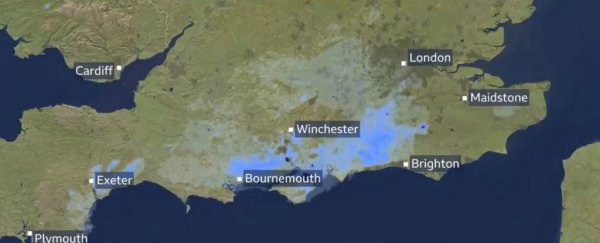On a dry summer day in July, the last thing the United Kingdom weather service expected to see on their radar was rain.
At first, it looked as though a light sun shower was falling on the south of England, but upon closer inspection, it was clear that these were not your average clouds. They were, in fact, alive.
According to experts, the mistaken masses of precipitation are actually swarms of flying ants, so dense in number they were picked up as raindrops by weather satellites in space.
"You can tell it's not rainfall because it has that eerie look to it," explained BBC weather presenter Simon King. "It doesn't quite match what rainfall looks like."
The latest view from space 📡 shows that our radar is picking up something that isn't #precipitation along the south coast 🤔 pic.twitter.com/N4eU9n6Z6A
— Met Office (@metoffice) July 17, 2019
'Eerie' doesn't begin to describe it, as residents of this region know all too well. This insect invasion is an annual swarming event, commonly known as 'Flying Ant Day', although it's more like a season, occurring at any time between June and the start of September, with a peak that lasts several days.
After a period of hot and humid weather, the black garden ants (Lasius niger) take to the skies in droves, cluttering the horizon, flying into homes and mouths, and distracting tennis players at Wimbledon.
Flying ants!!!
— Simon King (@SimonOKing) July 17, 2019
Swarms of them flying into the sky in S Eng are being picked up as rain on the radar image this morning...!#flyingantday #flyingants 🐜🐜🐜🐜#yuk pic.twitter.com/QGOcikqJFq
The whole affair is essentially like a debutante ball for young female ants. Signalled by the weather, these virgin queens emerge from their nests ready to start a new life; to ensure the best offspring possible, they put their potential mates through quite the ritual.
Releasing a string of pheromones on their nuptial flights, these queens attract a swarm of winged male ants, all of whom are ready to compete for her attention while seeking safety in numbers to try and avoid hungry birds ready to cash-in on their lust.
Once their flights of fancy are over, the male ants die and the queen ants return once more to the ground, burdened with sperm and ready to dig a new nest. If the endeavour is successful, the female ant should have mated enough to fertilise all her eggs for the rest of her life (usually about 20,000 eggs in some 15 years).
can always tell when the flying ants take off on the Norfolk coast as we have a sky filled with gulls having an easy meal!! pic.twitter.com/rUFFND7WcU
— Dave Bradley (@daveroybradley) July 17, 2019
This isn't the first time flying ants have been mistaken for raindrops. In 2017, the UK weather service noticed the exact same pattern.
From these recent sightings, it would be easy to conclude that flying ants are growing in number, but entomologist Adam Hart from the University of Gloucestershire told The Guardian he thinks this is probably just an indication of how sensitive our technology has become.
Something was picked up on our rainfall radar yesterday but it wasn't raining🤔... Was it a bird? Was it a plane? Vote in our poll below 👇 pic.twitter.com/rulUSPpfhf
— Met Office (@metoffice) July 18, 2017
Besides, even if they were increasing, he doesn't think it would be a bad thing. While 'Flying Ant Season' is usually considered a nuisance, it is also hugely beneficial to British ecosystems.
Not only are these ants a vital source of food for birds, the way that they tunnel and dig their nests has profound implications for the region's soil quality. So while a gardener might wish for rain amid this year's heat wave, perhaps a swarm of flying ants is the next best thing.
